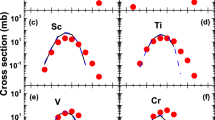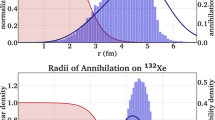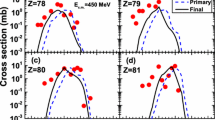Abstract
We propose a novel method for producing very-neutron-rich hypernuclei and corresponding resonance states by employing charge-exchange reactions via pp(\(^{12}\)C, \(^{12}\)N \(K^+\))n\(\varLambda \) with single-charge-exchange and ppp(\(^{9}\)Be, \(^{9}\)C \(K^+\))nn\(\varLambda \) with double-charge-exchange, both of which produce \(\varLambda K^+\) in a target nucleus. The feasibility of producing very-neutron-rich hypernuclei using the proposed method was analysed by applying an ultra-relativistic quantum molecular dynamics model to a \(^6\)Li + \(^{12}\)C reaction at 2 A GeV. The yields of very-neutron-rich hypernuclei, signal-to-background ratios, and background contributions were investigated. The proposed method is a powerful tool for studying very-neutron-rich hypernuclei and resonance states with a hyperon for experiments employing the Super-FRS facility at FAIR and HFRS facility at HIAF.






Similar content being viewed by others
Data Availability Statement
This manuscript has no associated data or the data will not be deposited. [Authors’ comment: This is a simulation study with transport model calculations and those analyses, and there are no experimental data associated. All model calculation tools are explained with references and our procedures are described also in details.]
References
D. Davis, 50 years of hypernuclear physics: I. Early Exp. Nucl. Phys. A 754, 3 (2005)
C. Rappold et al., Hypernuclear spectroscopy of products from \(^6\)Li projectiles on a carbon target at 2\(A\) GeV. Nucl. Phys. A 913, 170 (2013). https://doi.org/10.1016/j.nuclphysa.2013.05.019
C. Rappold et al., Search for evidence of \({}_{\varLambda }^{3}n\) by observing \(d+{\pi }^{-}\) and \(t+{\pi }^{-}\) final states in the reaction of \({}^{6}\)Li+\({}^{12}\)C at \(2A\) GeV. Phys. Rev. C 88, 041001 (2013). https://doi.org/10.1103/PhysRevC.88.041001
E. Hiyama et al., Three-body structure of the \(nn\varLambda \) system with \({\varLambda }N\)-\({\varSigma }N\) coupling. Phys. Rev. C 89, 061302 (2014). https://doi.org/10.1103/PhysRevC.89.061302
A. Gal, H. Garcilazo, Is there a bound \(^3_{\varLambda }\)n? Phys. Lett. B 736, 93 (2014). https://doi.org/10.1016/j.physletb.2014.07.009
H. Garcilazo, A. Valcarce, Nonexistence of a \({\varLambda }nn\) bound state. Phys. Rev. C 89, 057001 (2014). https://doi.org/10.1103/PhysRevC.89.057001
M. Schfer et al., The continuum spectrum of hypernuclear trios. Phys. Lett. B 808, 135614 (2020). https://doi.org/10.1016/j.physletb.2020.135614
I.R. Afnan, B.F. Gibson, Resonances in the \(\Lambda {\rm nn}\) system. Phys. Rev. C 92, 054608 (2015). https://doi.org/10.1103/PhysRevC.92.054608
S. Bleser et al., Has the neutral double hypernucleus \(^4_{\varLambda \varLambda }\)n been observed? Phys. Lett. B 790, 502 (2019). https://doi.org/10.1016/j.physletb.2019.01.047
The \(\text{R}^3\)B collaboration, Technical report for the design, construction and commissioning of NeuLAND: the high-resolution neutron time-of-flight spectrometer for \(\text{ R}^3\)B
K. Kisamori et al., Candidate resonant tetraneutron state populated by the \(^{4}{\rm He}(^{8}{\rm He},^{8}{\rm Be})\) reaction. Phys. Rev. Lett. 116, 052501 (2016). https://doi.org/10.1103/PhysRevLett.116.052501
M. Agnello et al., Evidence for heavy hyperhydrogen \(_{\varLambda }^{6}{\rm H}\). Phys. Rev. Lett. 108, 042501 (2012). https://doi.org/10.1103/PhysRevLett.108.042501
H. Sugimura et al., Search for \(^6_{\varLambda }\)H hypernucleus by the \(^6\)Li(\(\pi ^-\), \(K^+\)) reaction at \(p_{\pi }\) = 1.2 GeV/c. Phys. Lett. B 729, 39 (2014). https://doi.org/10.1016/j.physletb.2013.12.062
P.K. Saha et al., Production of the neutron-rich hypernucleus \(_{\varLambda }^{10}{\rm L}{\rm i}\) in the \(({\pi }^{-},{K}^{+})\) double charge-exchange reaction. Phys. Rev. Lett. 94, 052502 (2005). https://doi.org/10.1103/PhysRevLett.94.052502
Webpage of Super-FRS, https://fair-center.eu/en/for-users/ experiments/nustar/super-frs.html
Webpage of Facility for antiproton and ion research in Europe (FAIR), https://fair-center.eu
Webpage of high intensity heavy-ion accelerator facility (HIAF), http://hiaf.impcas.ac.cn/hiaf_en/public/c/news.html
T. R. Saito et al., Studies of the d+\(\pi ^-\) signal and lifetime of the \(^3_{\varLambda }\)H and \(^4_{\varLambda }\)H hypernuclei by new spectroscopy techniques with FRS, approved proposal S447 by GSI G-PAC
S. Bass et al., Microscopic models for ultrarelativistic heavy ion collisions. Prog. Part. Nucl. Phys. 41, 255 (1998). https://doi.org/10.1016/S0146-6410(98)00058-1
M. Bleicher et al., Relativistic hadron-hadron collisions in the ultra-relativistic quantum molecular dynamics mode. Nucl. Part. Phys. 25(9), 1859 (1999). https://doi.org/10.1088/0954-3899/25/9/308
Y.L. Sun et al., Production of light hypernuclei with light-ion beams and targets. Phys. Rev. C 98, 024903 (2018). https://doi.org/10.1103/PhysRevC.98.024903
A. Le Févre et al., FRIGA: a new approach to identify isotopes and hypernuclei in n-body transport models. Phys. Rev. C 100, 034904 (2019). https://doi.org/10.1103/PhysRevC.100.034904
C. Rappold et al., Hypernuclear production cross section in the reaction of \(^6\)Li + \(^{12}\)C at 2 \(A\) GeV. Phys. Lett. B 747, 129 (2015). https://doi.org/10.1016/j.physletb.2015.05.059
M. Roy-Stephan, Collective excitations of spin-isospin modes. Nucl. Phys. A 488, 187c (1988). https://doi.org/10.1016/0375-9474(88)90261-8
Acknowledgements
The authors thank H.J. Ong of the Institute of Modern Physics and S. Terashima of Beihang University for their fruitful discussions of charge-exchange reactions. The authors also thank J. Yoshida of RIKEN and Tohoku University for commenting on the manuscript.
Author information
Authors and Affiliations
Corresponding author
Additional information
Communicated by Alexandre Obertelli.
Rights and permissions
About this article
Cite this article
Saito, T.R., Ekawa, H. & Nakagawa, M. Novel method for producing very-neutron-rich hypernuclei via charge-exchange reactions with heavy ion projectiles. Eur. Phys. J. A 57, 159 (2021). https://doi.org/10.1140/epja/s10050-021-00470-3
Received:
Accepted:
Published:
DOI: https://doi.org/10.1140/epja/s10050-021-00470-3




